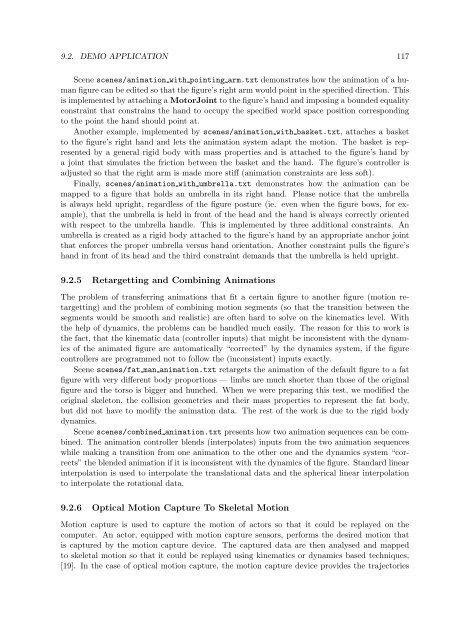thesis - Computer Graphics Group - Charles University - Univerzita ...
thesis - Computer Graphics Group - Charles University - Univerzita ...
thesis - Computer Graphics Group - Charles University - Univerzita ...
You also want an ePaper? Increase the reach of your titles
YUMPU automatically turns print PDFs into web optimized ePapers that Google loves.
9.2. DEMO APPLICATION 117<br />
Scene scenes/animation with pointing arm.txt demonstrates how the animation of a human<br />
figure can be edited so that the figure’s right arm would point in the specified direction. This<br />
is implemented by attaching a MotorJoint to the figure’s hand and imposing a bounded equality<br />
constraint that constrains the hand to occupy the specified world space position corresponding<br />
to the point the hand should point at.<br />
Another example, implemented by scenes/animation with basket.txt, attaches a basket<br />
to the figure’s right hand and lets the animation system adapt the motion. The basket is represented<br />
by a general rigid body with mass properties and is attached to the figure’s hand by<br />
a joint that simulates the friction between the basket and the hand. The figure’s controller is<br />
adjusted so that the right arm is made more stiff (animation constraints are less soft).<br />
Finally, scenes/animation with umbrella.txt demonstrates how the animation can be<br />
mapped to a figure that holds an umbrella in its right hand. Please notice that the umbrella<br />
is always held upright, regardless of the figure posture (ie. even when the figure bows, for example),<br />
that the umbrella is held in front of the head and the hand is always correctly oriented<br />
with respect to the umbrella handle. This is implemented by three additional constraints. An<br />
umbrella is created as a rigid body attached to the figure’s hand by an appropriate anchor joint<br />
that enforces the proper umbrella versus hand orientation. Another constraint pulls the figure’s<br />
hand in front of its head and the third constraint demands that the umbrella is held upright.<br />
9.2.5 Retargetting and Combining Animations<br />
The problem of transferring animations that fit a certain figure to another figure (motion retargetting)<br />
and the problem of combining motion segments (so that the transition between the<br />
segments would be smooth and realistic) are often hard to solve on the kinematics level. With<br />
the help of dynamics, the problems can be handled much easily. The reason for this to work is<br />
the fact, that the kinematic data (controller inputs) that might be inconsistent with the dynamics<br />
of the animated figure are automatically “corrected” by the dynamics system, if the figure<br />
controllers are programmed not to follow the (inconsistent) inputs exactly.<br />
Scene scenes/fat man animation.txt retargets the animation of the default figure to a fat<br />
figure with very different body proportions — limbs are much shorter than those of the original<br />
figure and the torso is bigger and hunched. When we were preparing this test, we modified the<br />
original skeleton, the collision geometries and their mass properties to represent the fat body,<br />
but did not have to modify the animation data. The rest of the work is due to the rigid body<br />
dynamics.<br />
Scene scenes/combined animation.txt presents how two animation sequences can be combined.<br />
The animation controller blends (interpolates) inputs from the two animation sequences<br />
while making a transition from one animation to the other one and the dynamics system “corrects”<br />
the blended animation if it is inconsistent with the dynamics of the figure. Standard linear<br />
interpolation is used to interpolate the translational data and the spherical linear interpolation<br />
to interpolate the rotational data.<br />
9.2.6 Optical Motion Capture To Skeletal Motion<br />
Motion capture is used to capture the motion of actors so that it could be replayed on the<br />
computer. An actor, equipped with motion capture sensors, performs the desired motion that<br />
is captured by the motion capture device. The captured data are then analysed and mapped<br />
to skeletal motion so that it could be replayed using kinematics or dynamics based techniques,<br />
[19]. In the case of optical motion capture, the motion capture device provides the trajectories
















